
Painting By The Numbers – March 2015, Canadian Packaging
By Andrew Joseph, Features Editor with Photography by Laura Tarquino
Automation Bottling Coding & Labeling Apple Barrel Bucilla Needlework Products Capmatic Ltd Cognex Corporation Delta Creative Enercon Industries Folk Art ID Technology Mod Podge Plaid Polypack Inc. Pro Mach Rockwell Automation Inc. Schneider Electric Canada slideshow Stencil DecorAmerican arts and crafts paint manufacturer gets inspired performance from state-of-the-art Canadian filling and capping equipment.
While the history of the company is a little hazy on whether the owners read a how-to book it published on how to create business success, what is undeniable is that Plaid Enterprises, Inc. of Norcross, Ga. has had 38 years of continuous successful growth, and is now considered a manufacturing leader of quality arts and crafts products for the retail segment.
When Plaid began operations in 1976, it did so as a family-run business with three employees publishing how-to books, expanding its domain between 1977 and 1989 to include products relating to: general crafts; home decorating; and paints and coatings.
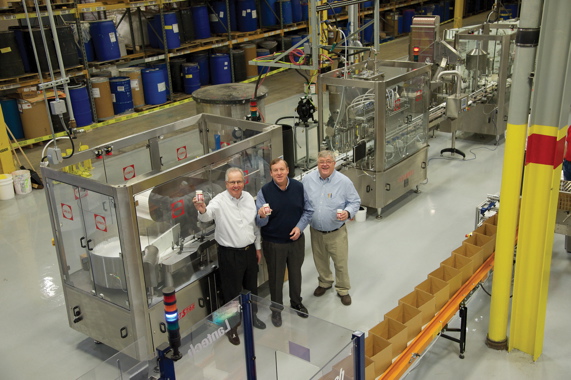
(From left): Plaid Enterprises, Inc. chief executive officer and president Mike McCooey; chief financial officer and chief operating officer John Michalek; and plant director Norman Thomas find good cheer with the turnkey Capmatic filling and capping line installed at the company’s 270,000-square-foot production facility in Decatur, GA.
The privately-held international investment holding firm Dyson Kissner-Moran Corporation purchased Plaid in 1989, which provided Plaid with growth opportunities thanks to DKM’s capital support structure.
Nowadays, the can-do know-how of Plaid has evolved the company into a firm with over 350 employees in the United States—and a sourcing office in Shenzhen, China—with over 5,000 SKUs (stock-keeping units) distributed in over 50 countries.
“Plaid manufactures and markets do-it-yourself products for customers worldwide, offering artist and craft acrylic paints and much more,” Plaid chief executive officer and president Mike McCooey told Canadian Packaging magazine during a recent interview.
Besides the arts and crafts paints, the 270,000-square-foot Decatur, GA.-facility located in the suburbs of Atlanta also manufactures stitchery kits, liquid adhesives and stencils, fashion products, jewelry, glues, and needlecrafts; decoupage products; products in areas such as faux finishes and glass crafts to new artists and markets, including home improvement; and soy paints and stains, and tools and accessories for decorative painters, home decor enthusiasts, and creative crafters.
But for Plaid, it certainly appears as though paint is where its current success lies, producing several million gallons a year of acrylics for fabric, wood, glass, ceramic, plastic, and metal projects; books, tools, and accessories for crafting.
“Roughly 80 per cent of what we manufacture is actually our own brands,” explains McCooey, citing the brands Folk Art and Apple Barrel, as well as Mod Podge, Plaid, Delta Creative, Bucilla Needlework Products and Stencil Decor. “The Plaid product portfolio currently offers 20 leading brands.”
McCooey adds that it’s not that hard to find Plaid brand products. Along with the distribution in over 50 countries, across North America, it can be found in such national movers as: Walmart, Target, Michaels, HomeDepot.com, Lowes, HSN (Home Shopping Network) and The Shopping Channel, Amazon, Ebay, Kroger, various dollar stores and many more.
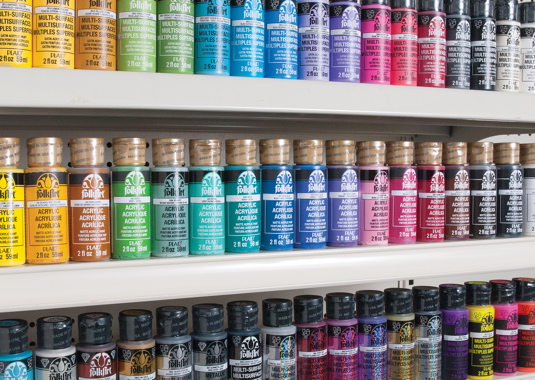
Plaid Enterprises manufactures and packages 20 of its own bestselling brands of arts and crafts paints such as Folk Art, Apple Barrel, Mod Podge and other labels.
ONLINE WONDER
But despite the proliferation of eager consumers waiting to snap up the arts and crafts materials from these businesses, Plaid and its social media partners also has a growing online presence (www.plaidonline.com), with over one-million followers across a variety of social media networks including 600,000 Google+ fans, 145,000 Facebook followers, 72,000 newsletter subscribers and an astounding 400,000 unique visitors to its daily blog that features original content from its Plaid craft design team, as well as craft experts and guest bloggers.
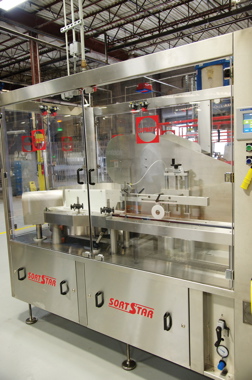
The Capmatic SortStar bottle unscrambler is specifically designed to handle a wide range of plastic bottle sizes without the operator needing to resort to change parts.
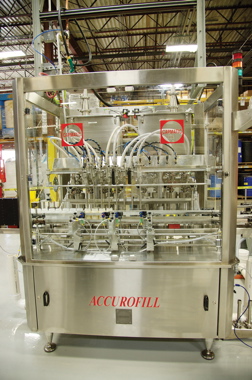
An Accurofill filler, designed and manufactured by Capmatic, is used to package a range of four- to 32-ounce arts and craft paint bottles at an average of 40,000 units per day.
“We use social media outlets to provide our followers and fans with daily ideas, inspiration and recipes, which of course helps drive retail performance,” mentions McCooey. “We even have Plaid Craft TV, 200 videos and counting of web-based craft programming with 36,000 subscribers on YouTube.”
While the company is social media savvy, it is also undeniably busy, operating its paints production facility 24/7, with no real cyclical peaks or valleys.
And yet, says McCooey, only a very small portion of its product is actually sold on-line, noting that Plaid’s low selling point of each SKU doesn’t usually warrant a consumer wanting to pay the additional shipping and handling costs.
“We are considered a major supplier in the craft industry,” relates McCooey. “Most of our product is sold directly to retailers, and it is important that we are cost-efficient to meet their pricing goals.”
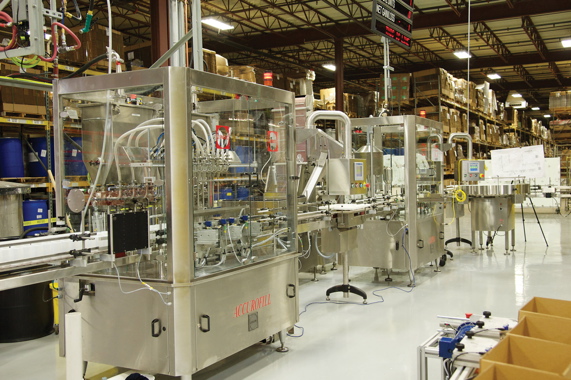
A side view of the No. 8 production line at Plaid, equipped with Capmatic’s Accurofill bottle filler, an Alpha chuck capper and an accumulation table.
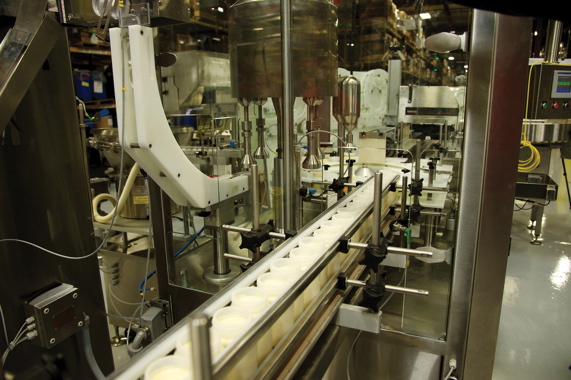
After plastic bottles are filled on the Accurofill, they are swiftly conveyed to an Alpha model capper—both manufactured by the Montreal-headquartered Capmatic Ltd.
At Plaid, raw materials are received either palletized or in tankers, and then common base paints are made some 2,000 gallons at a time and then stored until needed.
We have base storage tanks ranging in size from 3,000 to 6,000 gallons,” says Plaid chief financial officer and chief operating officer John Michalek, adding that most of its paints are common base.
“As for the unique batches, we make those one at a time in the 24 to 300 gallon range,” he notes.
After unique or common base paint is made, the batches are then tinted. Quality Assurance personnel then approves the batches after checking viscosity, pH, WPG (weight per gallon) and color.
After approval, these batches are moved to the packaging line for filling, with Michalek saying that Plaid tries to limit the wait for filling between 12 to 18 hours maximum.
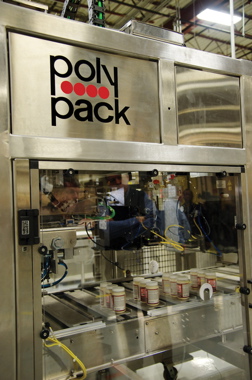
A Polypack ILB24L-P multipack shrink bundler featuring no transfer is used by Plaid to wrap unstable product multipacks of paint bottles.
The packaging process involves a stand-up unit or unscrambler standing the bottles upright in the line, filled, capped, induction sealed, cap retorqued, cap dot labeling, bundling, inner pack labeling, erecting and packing of corrugated cases, sealing the full cases, and then adding a master carton label to the side and top of the box.
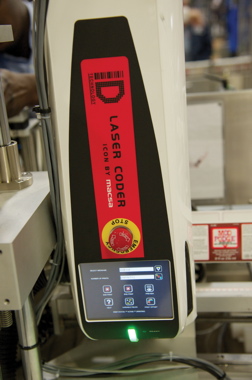
Plaid utilizes an iCON small-character laser coder manufactured by ID Technology, capable of printing up to four lines of text.
“The top labels on the master carton have a readable barcode, and is used by our team of order pickers to ensure the correct product is readied for customer delivery,” states Michalek.
After cartons are hand-stacked on pallets, shrinkwrapped and then sent to the warehouse, where if not directly sent to a product-pulling location, the pallet is placed into an overstock area.
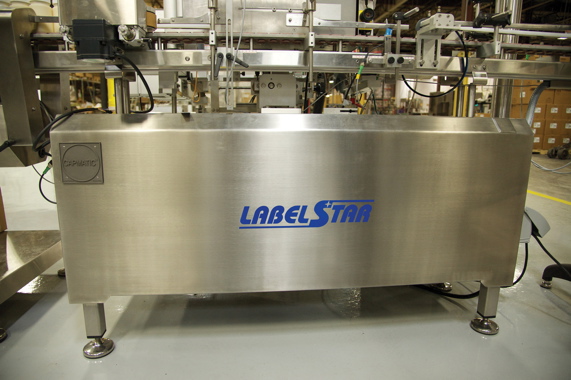
A Capmatic LabelStar System 1-Wrap wraparound inline labeling system places product labels around the round bottles at high throughput speeds.
Key to Plaid’s impressive production line efficiencies is a turnkey unit from Capmatic Ltd., that helps it achieve filling of a range of four- to 32-ounce bottles at an average of 40,000 units per day.
At the same time of the Capmatic purchase, Plaid also acquired new bundling equipment manufactured by Polypack Inc., consisting of an ILB24L-P multipack shrink bundler that can wrap any configuration of bottles, boxes, and odd-shaped items with its no-transfer wrapping that allows unstable-product multipacks to be produced; and a Polypack gantry case loader for the shrink bundler.
“Prior to our Capmatic line purchase, we did not have such a wide range of bottle filling applications,” relates Michalek.
Headquartered in Montreal, Capmatic designs and manufactures high-quality customized packaging equipment from semi-auto to fully-automatic systems and complete packaging lines.
Plaid purchased a complete turnkey system consisting of Capmatic’s:
- SortStar bottle unscramble;
- Accurofill 8H (eight head) piston filler;
- Alpha chuck capper;
- an accumulation table;
- LabelStar System 3-Top label application station;
- LabelStar System 1-Wrap around labeler;
- BeltStar re-tourquer;
- and an induction seal machine manufactured by Enercon Industries.
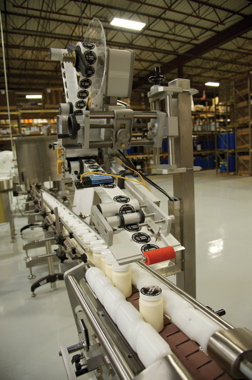
After filling and capping, a Capmatic LabelStar System 3 labeler is used to apply a top-dot adhesive label onto bottle caps for additional branding impact.
“With business being good and the future bright, we needed greater capacity, as well as a need to improve our quality control and productivity,” says McCooey. “It’s why we contacted Capmatic and then added our line No. 8, installing it during the last week of January 2015.”
According to Capmatic application engineer Domenic Imperiale, the project was virtually trouble-free right from the beginning.
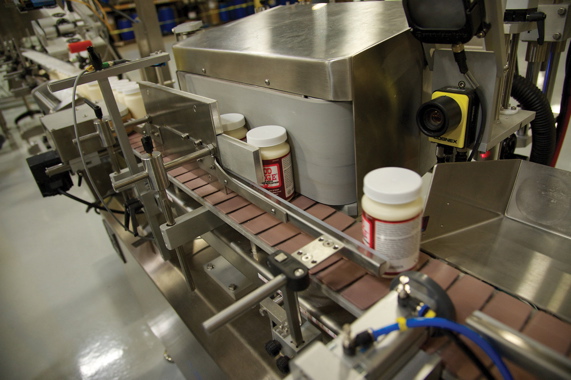
A Cognex vision system inspects and verifies the label positioning inside a Capmatic LabelStar System 1 labeler.
“After Plaid’s director of continuous improvement Arturo Gomez contacted us with a request for quality filling and capping equipment, I traveled to their facility to review their set-up and to analyze the issues they were having,” explains Imperiale. “I then created a report detailing what Capmatic could do to improve their production, reduce labor costs and improve the quality of their packaging to better support and supply their clients.”
He says he proposed Capmatic’s SortStar bottle unscrambler that requires no change parts; a custom-designed Accurofill filling machine that allows Plaid to perform product changeovers in five minutes or less; and an Alpha capper with a dual cap feeding station to minimize downtime.
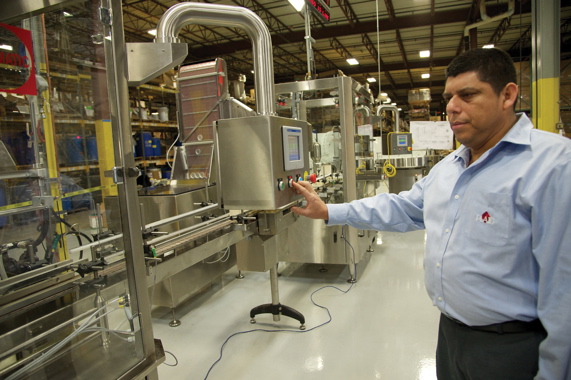
Line operator Oscar Rozales monitoring the HMI (human-machine interface) control panel on the SortStar bottle unscrambler.
“We also worked on the overall equipment layout to provide the minimum footprint, taking into account operator needs, while making the line as efficient as possible,” relates Imperiale.
The Capmatic SortStar bottle unscrambler is specifically designed to handle a wide range of plastic bottles. According to Imperiale, it uses a centrifugal disk and adjustable guides directly controllable through the Rockwell Automation Allen-Bradley brand HMI (human-machine interface) to allow it to run a variety of bottles without the need for any change parts. Any and all mechanical adjustments are equipped with numeric counters for easy and repeatable changes.
Though specially-designed, Plaid’s Capmatic Accurofill is indeed constructed from a base Capmatic automatic volumetric piston filler with specialized rotary valve systems that gives it the capability of filling liquids, semi-viscous and viscous products, such as: shampoo, cosmetic cream, cough syrup, chunky peanut butter, salsa, food product, petroleum gel, oil, and, of course, paint, which was specifically why Plaid purchased it.
The Accurofill also utilizes a Capmatic vision system to ensure the product corresponds to the correct bottle format.
For capping, the Alpha monoblock-style system was selected—a single-indexing multi-station platform which can be configured to handle many different applications. The machine is designed to work with free-standing containers or with the use of a puck system.
Although capping was the preferred method of closing system for Plaid, Imperiale says the Capmatic Alpha can also provide plugging, and crimping/R.O.P.P. (Roll On Pilfer Proof) closing systems.
Says Gomez: “We like the Alpha’s low profile design. It’s easy for our crew to clean and maintain. As well, it comes with removable stainless steel access doors on the front and back of the machine which gives, should we require it, quick and easy access to all internal hardware and electrical controls—it’s a wonderful design.”
According to Imperiale, the BeltStar retorquer capping system offers quality performance and maximum controlability for impeccable proficiency with regards to inline capping without the use of conventional spindles.
“It utilizes servo-driven belt systems to provide an accurate amount of torque, ensuring the paint caps are securely on, with no chance of leakage,” explains Imperiale. “It basically helps reduce rejects and improves line efficiency.”
The line also utilizes a labeling unit—two actually. The LabelStar System 1 is an inline labeling system that easily wrap applies labels around round bottles. It utilizes a feed screw, star-wheel indexing and a dual belt separator to provide extremely efficient label application.
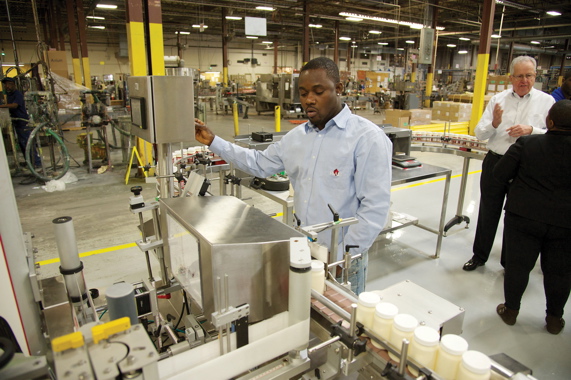
Plaid plant employee David Hall operating Capmatic’s LabelStar System 1 inline bottle wraparound labeling system.
As part of its quality assurances programs, Plaid uses an iCON small-character laser coder from ID Technology, a division of Pro Mach on the Capmatic LabelStar to apply specific lot code data, as well as a vision system manufactured by Cognex Corporation to ensure proper label alignment, and a reject system for any defective containers—all purchased via Capmatic for use with the filling/packing line.
A Capmatic LabelStar System 3 labeler is utilized near the end-of-the-line to apply labels to the top of caps and to the side of the master cartons filled with bottled paint product. It is capable of applying labels at speeds up to 250 per minute, but as Gomez admits, Plaid doesn’t require such speed at this juncture. Yet.
Keeping things green in more than a color scheme is also very important for Plaid, according Plaid director of operations Norman Thomas, saying the company has gone through great pains to ensure it is not merely compliant with sustainability issues, but exceeds them where possible.
“About seven years ago, Atlanta suffered through a drought,” begins Thomas. “Water is a major component in our paint, and any prolonged period with a water shortage would be devastating to our business.
“To avoid future instances of a prolonged drought affecting our production, we put down a well.
“Obviously the drought was not long, and since we never had to rely on the well water for our paint, we utilize it instead in our washdown routine and clean-up processes,” explains Thomas.
He adds that all of Plaid’s washdown water is recaptured and then sent to its own water treatment operation where the water is treated to pull the solids out before releasing it into the county sewage system.
In another example of keeping things green, Thomas says it recycles its cartons.
“We purchase our bottles from a local manufacturer and have them shipped to us in returnable cartons.
“Each carton contains 750 bottles and each carton is recycled in excess of 20 times before it needs to be replaced,” explains McCooey.
For Plaid, it saves some 66,600 cartons from ending up in the trash and landfill, and only has, as Thomas notes, had to replace a small number of cases each year.
All in all, Plaid Enterprises is extremely pleased with its new filling and packaging line from Capmatic.

Plaid Enterprises chief operating officer John Michalek (left) and plant director Norman Thomas examine filled arts and crafts paint bottles being conveyed to the high-performance LabelStar System 3 top cap labeling unit.
“Our continuous growth every year for 38 years has certainly put us in an enviable situation, as it proves consumers enjoy our high quality arts and crafts products,” sums up McCooey.
“Our new Capmatic line provides us with an upgrade on line efficiencies and capacity, as well as production speeds while enhancing our over-all quality assurance guidelines.
“We’re certainly in a great place right now for our current and future production requirements.”
Advertisement

